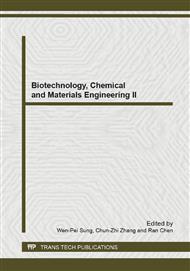[1]
E.C. Burgess, J. Ossa and T.M. Yuill: Avian Dis. Vol. 23 (1979), pp.940-949.
Google Scholar
[2]
A.J. Davison, R . Eberle, B. Ehlers, G.S. Hayward, D.J. McGeoch, A.C. Minson, P.E. Pellett, B. Roizman, M.J. Studdert and E. Thiry: Arch. Virolo. Vol. 154 (2009), pp.171-177.
DOI: 10.1007/s00705-008-0278-4
Google Scholar
[3]
C.M. Fauquet, M.A. Mayo, J. Maniloff, U. Desselberger, and L.A. Ball: Virus Taxonomy: Eighth Report of the International Committee on Taxonomy of Viruses (Academic Press, London 2005).
Google Scholar
[4]
K.A. Converse and G.A. Kidd: J. Wildlife Dis. Vol. 37 (2001), p.347–357.
Google Scholar
[5]
R. Gardner, J. Wilkerson, J.C. Johnson: Intervirology Vol. 36 (1993), pp.99-112.
Google Scholar
[6]
C.J. Shen, A.C. Cheng, M.S. Wang, Y.F. Guo, L.C. Zhao, M. Wen, W. Xie, H.Y. Xin and D.K. Zhu: Arch. Virolo. Vol. 154 (2009), pp.1061-1069.
Google Scholar
[7]
B. Lian, C. Xu, A.C. Cheng, M.S. Wang, D.K. Zhu, Q.H. Luo, R.Y. Jia, F.J. Bi , Z.L. Chen, Y. Zhou, Z.X. Yang and X.Y. Chen: Virol. J. Vol. 349 (2011), pp.1-11.
Google Scholar
[8]
L.C. Zhao, A.C. Cheng, M.S. Wang, G.P. Yuan, R.Y. Jia, D.C. Zhou, X.F. Qi, H. Ge, and T. Sun: Avian Dis. Vol. 52 (2008), pp.324-331.
Google Scholar
[9]
J. Conner, H. Marsden and J.B. Clements: Rev. Med. Virol. Vol. 4 (1994), pp.25-34.
Google Scholar
[10]
J.M. Cameron, I. McDougall, H.S. Marsden, V.G. Preston, D.M. Ryan and J.H. Subak-Sharpe: J. Gen. Virol. Vol. 69 (1988), pp.2607-2612.
Google Scholar
[11]
J. Furlong, J. Conner, J. McLauchlan, H. Lankinen, C. Galt, H.S. Marsden and J.B. Clements: Virology Vol. 182 (1991), pp.846-851.
DOI: 10.1016/0042-6822(91)90627-n
Google Scholar
[12]
P. Nordlund and P. Reichard: Annual Review of Biochemistry Vol. 75 (2006), 681-706.
Google Scholar
[13]
C.K. Mathews: The FASEB Journal Vol. 20 (2006), pp.1300-1314.
Google Scholar
[14]
E. Torrents, M. Sahlin and B.M. Sjoberg: The ribonucleotide reductase family-genetics and genomics (NovaScience Publishers, New York 2008).
Google Scholar
[15]
T. Radivoyevitch: BMC Systems Biology Vol. 15 (2008), pp.1-13.
Google Scholar
[16]
A.C. Cheng, M.S. Wang, M. Wen, W.G. Zhou, Y.F. Guo, R.Y. Jia, C. Xu, G.P. Yuan, Y.C. Liu: High Technol. Lett. Vol. 16 (2006), pp.948-953.
Google Scholar
[17]
J. Shao, B. Zhou, C. Bernard and Y. Yen: Current Cancer Drug Targets Vol. 6 (2006), pp.409-431.
Google Scholar
[18]
J. Herrick and B. Sclavi: Mol. Microbiol. Vol. 63 (2007), pp.22-34.
Google Scholar
[19]
G. Delhon, M.P. Moraes, Z. Lu, C.L. Afonso, E.F. Flores, R. Weiblen, G.F. Kutish and D.L. Rock: Virology Vol. 77 (2003), pp.10339-10347.
DOI: 10.1128/jvi.77.19.10339-10347.2003
Google Scholar
[20]
S.D. Tyler, G.A. Peters and A. Severini: Virology Vol. 331 (2005), pp.429-440.
Google Scholar
[21]
V.G. Preston, J.W. Palfreyman and B.M. Dutia: J. Gen. Virol. Vol. 65 (1984), pp.1457-1466.
Google Scholar
[22]
L.M. Iakoucheva, P. Radivojac1, C.J. Brown, Tr.O. Connor, J.G. Sikes, Z. Obradovic1 and A.K. Dunker: Nucleic Acids Res. Vol. 32 (2004), pp.1037-1049.
Google Scholar
[23]
N. Blom, S. Gammeltoft and S. Brunak: J. Mo. Biol. Vol. 294 (1999), pp.1351-1362.
Google Scholar
[24]
H.R. Griffiths: Autoimmun. Rev. Vol. 7 (2008), pp.544-549.
Google Scholar
[25]
S.M. Chi: Biochem. Bioph. Res. Co. Vol. 399 (2010), pp.402-405.
Google Scholar
[26]
T. Sun, A.C. Cheng, M.S. Wang, Y.F. Guo, R.Y. Jia and C.J. Shen: Veterinary Science in China Vol. 38 (2008), pp.939-945.
Google Scholar
[27]
C. Xu, X.R. Li, H.Y. Xin, B. Lian, A.C. Cheng, M.S. Wang, D.K. Zhu, R.Y. Jia, Q.H. Luo and X.Y. Chen: Chinese Veterinary Science Vol. 38 (2008), pp.1038-1044.
Google Scholar
[28]
D.J. Barlow, M.S. Edwards and J.M. Thornton: Nature Vol. 322 (1986), pp.747-748.
Google Scholar
[29]
H Chang, A.C. Cheng, M.S. Wang, Y.F. Guo, W. Xie and K.P. Lou: Arch. Virol. Vol. 154 (2009), pp.163-165.
Google Scholar
[30]
M.S. Cai. A.C. Cheng, M.S. Wang, L.C. Zhao, D.K. Zhu, Q.H. Luo, F. Liu and X.Y. Chen: Intervirology Vol. 52 (2009), pp.266-278.
Google Scholar
[31]
R.Y. Jia, A.C. Cheng, M.S. Wang, H.Y. Xin, Y.F. Guo, D.K. Zhu, X.F. Qi, L.C. Zhao, H. Ge and X.Y. Chen: Virus Genes Vol. 38 (2008), pp.96-103.
Google Scholar
[32]
L.C. Zhao, A.C. Cheng, M.S. Wang, G.P. Yuan and M.S. Cai: Prog. Nat. Sci. Vol. 18 (2008), p.1069–1076.
Google Scholar


